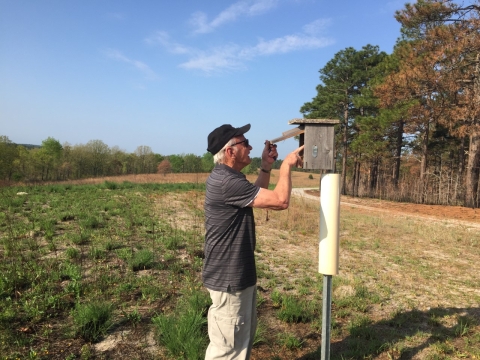“This is for the birds.”
Some may utter the familiar phrase in frustration.
That’s not the case with Don Crutchfield who volunteers every week at Carolina Sandhills National Wildlife Refuge.
When he says it, he means it.
When Crutchfield first visited Carolina Sandhills as part of an organized community walk, he immediately fell in love with it.
“It’s such a beautiful place, so much to see and do,” Crutchfield says. “I liked it so much, I asked the manager ‘whatcha got I can do out here?’”
Lyne Askins, the project leader at Carolina Sandhills, had just the project for him: taking care of the bluebird population.
He now manages almost 70 bluebird boxes. During the last nine years, the octogenarian, has built and installed 50 of those throughout the 45,000-acre property.
Bluebirds build their nests in cavities, but they don’t create the cavities in the longleaf pines found at the refuge. Instead, bluebirds move into cavities vacated by a woodpecker – or – into one of Crutchfield’s boxed cavities.
Before nesting begins, Crutchfield lovingly cleans and repairs existing boxes and installs new ones, doing what he can to protect the feathered families from predators, namely snakes. Throughout nesting season, which runs March through August at Carolina Sandhills, he returns to each box, making sure it’s ready for the feathered mama. Crutchfield explains that the birds may nest up to three times each season.
That’s a lot of walking around the refuge, but he keeps going.
In addition to creating a safe, clean home for the bluebirds, Crutchfield also helps U.S. Fish and Wildlife Service biologists study the bird. When not tending to the boxes, he’s counting eggs, making notes of when the eggs are laid, when they hatch, how long before they take off on their own, and if any other bird species have moved into the boxes. The data helps maintain the boxes so bluebirds continue having a safe place to nest.
“Mr. Crutchfield's contribution to the bluebird box program is very important, as are all of our volunteers,” said Nancy Jordan, a Service biologist at Carolina Sandhills National Wildlife Refuge. ‘With reduced staff levels, quite honestly, we would not be able to maintain [the boxes] as well as he does nor would we be able to collect nesting data.”
The refuge is a haven, not only for bluebirds, the endangered red-cockaded woodpecker and other wildlife, but for Crutchfield also. He explains that when he’s “down or blue,” he’ll head to Carolina Sandhills.
“This place is a sanctuary for me. It refreshes me. It truly is something else. It means so much to me,” Crutchfield says.
The impact on Crutchfield is evident, according to Jordan.
“This partnership is wonderful on many levels. Mr. Crutchfield gets a lot of joy from helping ‘his’ bluebirds, and I get joy from seeing how much it enriches his life,” she says.
While he enjoys what he does at Carolina Sandhills National Wildlife Refuge and plans to continue volunteering for some time, Crutchfield says there’s something for everyone to do or enjoy there, including the youngest of volunteers.
“I’d like to see more youth involved out here.”
Editor’s note: During National Volunteer Week, the U.S. Fish and Wildlife Service’s Southeast Region celebrates the efforts of generous volunteers who contribute to the agency’s mission of working with others to conserve, protect, and enhance fish, wildlife, plants, and their habitats for the continuing benefit of the American people. For more information on volunteer opportunities, go to https://www.fws.gov/volunteer-opportunity .





